Caring For An Aging City

On the front lines with New York's visiting nurses
Aging in New York City has always been harder than in other cities: Consider walk-up apartments, trouble using public transportation, and pressure from aggressive landlords to free up rent-stabilized apartments.
Amealya Blake has been working as a registered nurse for 11 years, covering a 20-block radius on the Upper West Side for the Visiting Nurse Service of New York, a not-for-profit organization that helps approximately 163,500 New Yorkers stay in their homes.
Many of her patients live in the Lincoln Towers apartment complex at 170 West End Ave. between 66th St. and 70th St. Growing up in the Bronx, she is familiar with both the positives and negatives that come with living in New York City. She applies this understanding and familiarity to helping her patients adjust to aging in New York comfortably.
"The closeness and convenience of everything is what Manhattan really has to offer seniors," she explained. "I'm able to really get to know my patients since I am assigned to one neighborhood, and we try to offer different ways of promoting different ways for seniors to socialize and stay healthy." In partnership with VNSNY and Lincoln Towers, Blake helps with the community program Project Open, which offers a monthly blood pressure clinic.
Visiting an average of 10 patients per day, Blake has seen a rapid increase in the number of seniors who need at-home care. In addition, there is a lack of space in nursing homes, and many families cannot even afford to send their loved ones to a home. Blake mentioned that although she once wanted to work in a hospital, she realized that working with her patients in their own home allows her to give each patient much more specialized and effective care.
Most of the patients using VNSNY have been assigned case workers, nurses, physical therapists, and occupational therapists after they have been discharged from the hospital, helping seniors through a variety of life changes. "It is a very sensitive and critical time for patients when they first come home from the hospital," Blake said. "It is my job to help someone comfortably transition back into their daily life."
Kathy Petrullo also started working for VNSNY 11 years ago, working as an occupational therapist assisting patients with activities in daily living. When someone has been referred to VNSNY, they are assigned a social worker who evaluates the necessary services needed, and the number of visits that will best benefit the patient.
"It really is a multi-team effort, we all have different perspectives and responsibilities so communication is very important," Petrullo explained. Having worked in a hospital for four years, she has also seen the added benefits of assisting seniors in their home. "I really thought I could be more effective working in their actual living environment. At the hospital I always had to make these blind assumptions based on the little information I had about their at home lives."
Describing at-home caretakers as the bridge between the hospital and home, Pertrullo pays very close attention to small dangers around apartments that can lead to dangerous falls, and other injuries. She starts her day by calling to confirm appointments. By 11 a.m. she has started seeing her patients, averaging six visits a day. Pertrullo covers the Upper West Side neighborhood from 126th St. and Riverside Dr. to 148th St.
"I don't ever look at the clock when I am with one of my patients, because for me I just want to make sure that everything is taken care of before I leave," Pertrullo explained. The end of her day is used to fill out the necessary documentation, making doctor's appointments, and ordering equipment like tub benches, railings, and supportive bedding.
"People are getting released from hospitals and nursing homes a lot earlier than they used to," explained Pertullo. "It is important to recognize that not only will there be more seniors living in New York, but people are living much longer lives. Improving their quality of life is the most important thing."